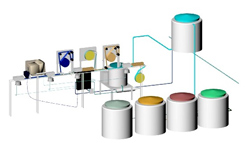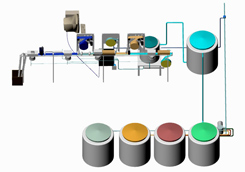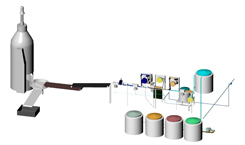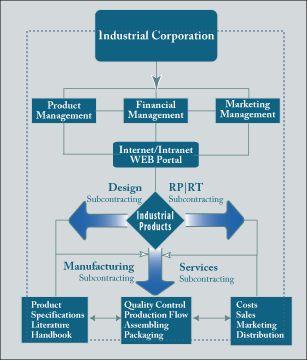 |
|
|
| INTERNATIONAL PROGRAM | INDUSTRIALLY DEVELOPED COUNTRIES | |
|
|
| |
INDUSTRIAL SYSTEMS DESIGN &
INTERNATIONAL
PRODUCTS DEVELOPMENT
The
series of articles program
consists of modern industrial systems automated
or semi-automated development
and adapted to the quick change of products
inside the same production line, including FMS– Flexible
Manufacturing Systems, or industrial cell
systems and Rapid Products Development, rapid prototyping
and
rapid tooling.
Inside these concepts new several raw materials, processes,
design and technologies are proposed in our international
partnerships with researchers, Institutions and
development centers, engineering and industrial design
companies , industrial systems
design and raw materials manufacturers.
A great range of products
is accessible in partnerships and available for immediate
production, may possibly
include molds tools and complete systems
ready for
production.
Information links are provided
about all proposed themes.
|
__ INDUSTRY MAIN TRENDS __
Establishing
main parameters for the current
industrial development, it can
be defined two main
axes as trends from the last
years:
¤ FMS – Flexbile
Manufacturing Systems
¤ Industrial Systems without own industrial facilities
Other tendencies
can be mentioned, but that are composed mainly
inside trends of ramifications as Petroleum,
Chemistry, Mechanics of Precision.
|
|
| |
FMS - FLEXIBLE MANUFACTURING SYSTEMS
Basically
a FMS is defined as an integrated and automated production
system containing:
(a) flexible
process equipment, normally automated machines with numeric
control and equipped with
quick tool change ability,
(b)
material handling equipment including transfer
lines or conveyor belts, forklifts, elevators,
automated guided vehicles (AGVS) as well as
automated storage and inventory handling systems
such as automated storage and retrieval
systems (ASRS),
(c) sophisticated computerized communication and control systems integrating
process and material handling equipment, and
(d) a modern maintenance support structure that can bring the system
quickly back to normal after equipment failure.
FMS is designed mainly for the existence
of multiple production lines inside the same facility,
or even for the fast change of production lines. FMS for
its properties adapts mainly for the industrial suppliers
working for third-parties, and they are especially
endowed with versatile systems capable to comprehend
an extensive production range inside a domain, as assembling,
plastics production, chemical, agro-industry, machining
and mechanical assembling, involving even finishing
and
packaging.
The images represent the schematic FMS Hydrogel plant in
a project funded by International Atomic Energy Agency
(IAEA) and IPEN Nuclear Energy Research Institute.
Fig.1 (top) represents the basic process with magazine
for molds tools swap on the blistering machine, with
automated conversion of ingredients addition.
Fig. 2 (center) represents the FMS plant including a
system where packaging recipients inside the mold cavities
(interchangeable magazine) serves as mold shape for Hydrogel.
The packaging systems is integrated to the process.
Fig. 3 is a schematic
FMS plant including packaging systems and irradiation
unity.
 See FMS - Flexible
Manufacturing Systems Design article See FMS - Flexible
Manufacturing Systems Design article
|
 |
 |
 |
_________________________________________________
INDUSTRIAL
SYSTEMS
Without own industrial facilities
Industrial
corporations without own industrial facilities have
been effectively the most important trend of the
last fifteen years, beginning with the large
multinational corporation and reaching nowadays every
levels of correlated
industry mainly within the international
market.
The evolution of the subcontracting systems all over
the world and the vertiginous increasing of the efficiency
progress of the services and production suppliers, quality
and time optimization, transformed the industrial perspective.
Pressing
the traditional models with the new economical models,
and causing a spectacular reduction in the periods,
the system of industrial subcontracting reached unexpected
domains.
The reduction of the industrial corporate administration
team, also forces to an optimization of the functions
and amplification of the skills and responsibilities.
The decision-making is more reliable, but it holds
more centralized consequences and responsibilities.
|
____________________________________________
STAFF & SKILLS
New
Industrial Model
The nature and character of the
current international environment which staff works in
new industrial corporation is now more complex than ever,
and the skills that are needed extend beyond Information
and Communication Technologies to embrace the analytical
and evaluative skills essential to effective information
management. In
the new staff roles is important to define and map
staff development needs and thrust in terms
of their
information skills, creating a model for staff
to use in developing their information resources.Continue
collaboration with key staff development and information
agencies/organization, including
the development
of a ‘roadmap’ to their various roles
and initiatives, providing guidelines and advice
for the
company on developing their staff’ information
skills and the expected benefits for the organization
and the productive system development.Some
of these information's are available at Internet
as marketing reports and analysis for
each domain
and locality, since US$50. Workings in an electronic
environment
increases dependency on information; identify,
assess, retrieve, evaluate,
adapt, organize and communicate information
within an recurring context of evaluation and deliberation.It
is of highest importance that all staff employed
in the industrial corporation sector is
given support
to develop confidence and competence in
their ability to identify and apply quality information,
to inform
and add value to their working proceedings.It
is evident that staff needs more than just
particular skills to feel confident
working with the wide range
of information sources available today;
consider the cumulative impact of recent industrial
tasks
development, the incremental shift from
informative to structuring
productive chains.
The
most important benefits from a motivated staff are
improving information flow,
use of existing resources,
return on investment, research capability,
and enhance market profile and reputation.
|
_____________________________________
INDUSTRIAL
SYSTEMS
Subcontracting Model
The schematic model distributes
the basic components of the industrial structure of subcontracting,
considering as successfully efficient a basic structure
from a staff
of three qualified managers to ten/twelve
for the administration of 20/25 products in the international
market. Starting from the establishment of a reliable Intranet/Internet
portal, the actions of the team lead using this tool
to interact among information agencies/institutions (marketing,
consultants, analysts), services (Design, engineering,
prototyping, molds and tools), producers (industrial
suppliers) and distribution. Effectively the development
stage doesn't settle down on a sequential way, but intercalated,
compelling to multiple
tasks during the development period. The model establishes above all horizontal structures
than vertical, or meaning all the team members shall
interact in the decisive process; in reality the model
demonstrates in the outline, it even imposes the interaction
among the several suppliers (services, goods and consultants). The principal net benefits of this structure it is the
elimination of the periodic flotation (seasonality),
maintaining an increasing evolution of the profitability,
and suspending acquisitions when the market is reduced
without implicating in maintaining a structure of workforce,
facilities, machines and equipments. Other benefits may
be Improved use of existing resources, return on investment,
and research capability.
The
complete presentation of tasks, functional organization
and optimization
may be seen in RPD–Rapid Product
Development.
|

Integrated International Subcontracting Scheme
Advanced
IT – Information Technology Systems have to be
provided for a reliable International industrial company
without
own industrial facilities. An optimized team enclosing
the four main responsibilities supports the organization:
Company header, Product Management, Financial Management,
and Marketing Management.
Within each division in the Intranet/Internet WEB Portal
the KM – Knowledge
Management system, arrange and dispose to all team the main information related
to each initiative, state, situation, and involved decisions or tasks.
The external services, suppliers and consultant interact with the manager's team
by means of Internet/Intranet WEB portal and other communications interfaces
(fax, telephone, etc).
Every data from budgets, invoices, data, costs, orders, are integrated to Intranet
Portal in real time, and by means of administration interfaces, integrating all
available data, files, pictures, and documents.
The integrated system updates directly all data from statistics, cash flow, storage
flow, orders, requests, and information.
The databases are integrated to the Knowledge Management system supplying updated
information on real-time.
|
|
|
|
|
|
|
|
|
